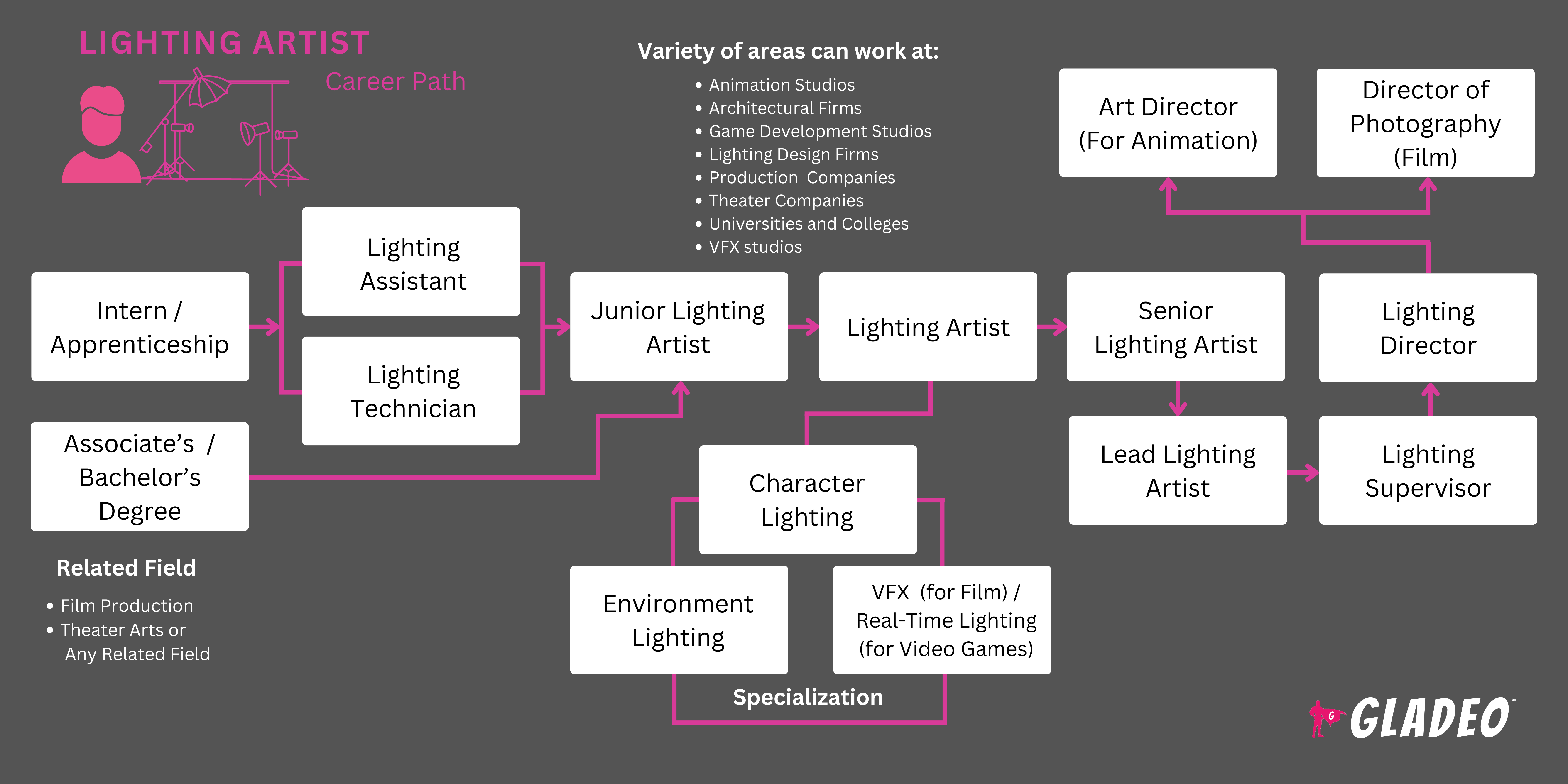Focos de atención
Lighting Technical Director, Lighting Specialist, Lighting Supervisor, Lighting Compositor, Lighting and Rendering Artist, Lighting and Shading Artist, Illumination Artist, CG Lighting Artist, Lighting TD (Technical Director), Visual Effects Lighting Artist
Have you ever watched a movie or played a video game and thought, “Wow, that’s some great lighting!”?
If not, you’re not the only one. Most audiences don’t think about all the work that goes into creating dynamic, realistic lighting effects. And yet, without those effects, we’d certainly notice the difference! Working closely with directors, cinematographers, and other artists, they ensure lighting complements every scene's tone, setting, action, and artistry.
Despite often being overlooked, Lighting Artists play a major role in film, TV, video game, and theatrical productions. They create and manipulate lighting effects to enhance scenes and environments, making them appear more dramatic and visually appealing. Whether it’s highlighting an actor’s facial expression, creating a moody nighttime ambiance, or spotlighting the dancers on a stage, their work can be seen in virtually every second of any given production.
- Enhancing visual storytelling through creative lighting techniques
- Collaborating with diverse teams to achieve a unified artistic vision
- Seeing the immediate impact of your work on the production’s visual quality
- Opportunities to work on a variety of projects in different media
Horario de trabajo
- Lighting Artists typically work full-time, with overtime needed to meet production deadlines. They may work in studios, on location, or in theaters. Some work on a per-project basis.
Tareas típicas
- Analyze scripts and storyboards to determine lighting requirements for each scene
- Develop lighting concepts that align with the overall visual style and mood
- Provide input during pre-production meetings to shape the project’s visual narrative
- Coordinate with the art department to integrate lighting plans with set designs and props
- Manage the setup, operation, and maintenance of lighting equipment on set or location
- Ensure lighting equipment is calibrated and functioning before and during production
- Common lighting equipment used in films includes Fresnel lights, Parabolic Aluminized Reflector lights, Hydrargyrum Medium-Arc Iodide lights, LED panels, tungsten lights, Kino Flo lights, softboxes, Dedo lights, Century Stands, and reflectors
- Work with various lighting effects software programs, especially for virtual productions, computer-generated graphics, video games, etc.
- Implement lighting effects such as shadows, highlights, and color grading
- Adjust lighting setups to accommodate changes in camera angles or scene-blocking
Responsabilidades adicionales
- Stay informed about emerging lighting technologies and trends
- Ensure compliance with safety standards and protocols
- Train and mentor junior lighting artists and technicians
Habilidades blandas
- Adaptabilidad
- Atención al detalle
- Calma bajo presión
- Colaboración
- Habilidades de comunicación
- Habilidades de conceptualización
- Creatividad
- Decisividad
- Orientado al detalle
- Empatía
- Flexibilidad
- Paciencia
- Persistencia
- Habilidades para resolver problemas
- Trabajo en equipo
- Narración visual
Habilidades técnicas
- Basic cinematography and visual effects knowledge
- Teoría del color
- Framing and staging shots
- Industry-standard software like Maya, Houdini, Chaos, Arnold, RenderMan, and Photoshop
- Real-time rendering engines such as Unreal Engine
- Lighting instruments and equipment such as Fresnel lights, Parabolic Aluminized Reflector lights, Hydrargyrum Medium-Arc Iodide lights, LED panels, tungsten lights, Kino Flo lights, softboxes, Dedo lights, Century Stands, and reflectors
- Physical and digital lighting rigs
- Technical troubleshooting on set and in post-production
- General understanding of the roles of different production departments
- Empresas de publicidad y relaciones públicas
- Animation studios
- Film and television production companies
- Trabajo autónomo o independiente
- Performing arts venues (theater, concerts, dances, exhibitions, etc.)
- Difusión de la televisión
- Video game studios
Lighting Artists must produce visually compelling lighting that enhances productions that are often very expensive. Thus, the pressure is on to ensure things are done right the first time, to avoid delays and potential cost overruns.
In addition, Lighting Artists often work in challenging environments such as outdoor locations, where they must adapt to changing weather and natural light. They have to stay flexible in case of last-minute changes that require adjusting lighting setups.
Effective collaboration is crucial since Lighting Artists must coordinate with different departments, including cinematography, art direction, and post-production, to ensure a cohesive visual aesthetic. The job can be demanding at times, with long hours and pressure to meet deadlines. But the rewards of seeing your work on screen or stage can be very fulfilling!
Within the lighting industry, there’s an increased focus on sustainability and eco-friendly lighting practices, such as LED options that reduce energy consumption and environmental impact. Digital lighting techniques and virtual production are also more common, allowing Lighting Artists to create dynamic, flexible setups in CGI environments. In addition, the integration of lighting with other visual effects such as augmented and virtual reality is pushing the boundaries of what can be achieved in visual storytelling!
Growing up, Lighting Artists may have enjoyed photography and experimenting with light and shadows. They might have also participated in theater productions, helping with stage lights or other setups.
- Lighting Artists often obtain a bachelor’s degree in film production, theater arts, or a related field
- Los cursos pertinentes pueden incluir:
- 3D Lighting and Rendering
- Cinematography
- Teoría del color
- Digital lighting software
- Interactive Lighting in Virtual Production
- Light and Shadow in Visual Storytelling
- Lighting for Animation
- Lighting for Green Screen and Compositing
- Lighting for High Dynamic Range (HDR) Imaging
- Photometric Analysis for Film and Theater
- Set Design and Lighting Integration
- Stage Lighting Design
- Note, a college degree is not always a strict requirement for becoming a Lighting Artist. Many have been able to qualify for their job through alternative means such as:
- On-the-job training, starting as an assistant or lighting technician
- Apprenticeships working under experienced Lighting Designers or Gaffers
- Workshops and short courses focused on lighting for film
- Self-study and practice using online resources and tutorials
- Freelance work on small independent projects
- Certifications in lighting software and equipment such as credentials in Autodesk Maya, Houdini, Chaos, Arnold, Unreal Engine, lighting consoles like ETC’s Eos or MA Lighting’s GrandMA, or DaVinci Resolve
- Las certificaciones adicionales incluyen:
- International Association of Lighting Designers - Certified Lighting Designer
- International Alliance of Theatrical Stage Employees - Certified Film Lighting Technician
- Unreal Engine - Virtual Production Lighting Certification
- Unity Technologies - Real-Time Lighting for Video Games Certification
- Considere el coste de la matrícula, los descuentos y las oportunidades de becas locales (además de la ayuda federal).
- Think about your schedule and flexibility when deciding whether to enroll in an on-campus, online, or hybrid program. Ideally, you’ll want as much hands-on practice as you can get.
- Check out the program’s faculty accomplishments to see what projects they’ve worked on.
- Look closely at the school’s facilities and the equipment and software that students train on.
- See if the program offers opportunities for hands-on learning through internships or cooperative education with production companies.
- Consulta las estadísticas de colocación y los detalles sobre la red de antiguos alumnos del programa.
- Take courses in lighting design, cinematography, photography, and digital lighting software
- Gain experience through internships or part-time jobs in film, TV, or theater production focusing on lighting
- Build a portfolio or demo reel of your work, including lighting setups and designs from various projects
- Stay informed about current trends in film lighting and visual effects
- Attend film festivals, lighting workshops, and industry events. Network with professionals in the lighting and cinematography industry. Join professional organizations for lighting artists
- Join audiovisual clubs or volunteer for school or community theater productions to gain hands-on lighting experience. Seek a mentor who can guide you through education and training choices
Start working on small film projects, focusing on lighting design, and share them on platforms like YouTube or Vimeo - Study books, articles, and video tutorials related to lighting design and cinematography (see our list of Resources > Websites)
- Get to know the major departments of film productions to understand how lighting interacts with other elements
- Watch films and behind-the-scenes videos. Study the use of lighting, effects, and camera work
- Take notes on techniques used in different genres and scenes
- Borrow or rent lighting equipment to get practical experience and experiment with different setups
- Get familiar with video editing software and how lighting choices impact post-production
- Advertise your freelance lighting services in the local area or online to gain experience
- Apply for film and theater internships focusing on lighting design until you land one

- Use job portals like Indeed and industry-specific websites like Staff Me Up to find opportunities
- Prepare a strong portfolio, demo reel, and resume to highlight your skills and experience
- Review Lighting Artist resume templates to get ideas for formatting and phrasing
- Notice the keywords used in job postings and try to work those into your resume. Keywords might include:
- Color Grading
- Composición
- Lighting Design
- Mood Lighting
- Photorealistic
- Presentación
- Scene Optimization
- Shading
- Efectos visuales
- Utilize your school’s career services for job search assistance, resume writing, and interviewing
- Ask your program if they have industry connections that could help you
- Let your network know you are looking for jobs or internships, as many opportunities are filled through personal and professional connections
- Participate in industry conferences and expos to showcase your work
- Chances are you’ll have to apply for entry-level jobs and work your way up to higher roles. Many Lighting Artists start as assistants or interns
- Build your reputation and ensure your work is seen by entering film festivals, promoting your work on social media, and getting published in industry journals or on popular websites
- Move to where the most film and TV jobs are, such as California, New York, Texas, Florida, and Georgia
- Hop on forums and start asking job advice questions and requesting answers from working professionals
- Pide a tus profesores, supervisores y compañeros que te sirvan de referencias personales
- Study interview questions such as “How do you approach creating lighting that enhances the mood and atmosphere of a scene while maintaining visual consistency across multiple shots?” or “Can you describe a challenging project where you had to creatively solve a lighting issue? What was the problem, and how did you address it?”
- Always dress appropriately for job interview success
- Consistently deliver innovative, high-quality lighting effects
- Seek additional training and certifications in lighting software and equipment such as credentials in Autodesk Maya, Houdini, Chaos, Arnold, Unreal Engine, lighting consoles like ETC’s Eos or MA Lighting’s GrandMA, or DaVinci Resolve
- Las certificaciones adicionales incluyen:
- International Association of Lighting Designers - Certified Lighting Designer
- International Alliance of Theatrical Stage Employees - Certified Film Lighting Technician
- Unreal Engine - Virtual Production Lighting Certification
- Unity Technologies - Real-Time Lighting for Video Games Certification
- Participate in industry conferences and events to gain exposure
- Develop an online presence to market your work
- Continue learning more about everyone else’s roles
- Treat people with respect, always be well-prepared, and stay calm under pressure
- Watch and learn from more senior Lighting Artists. Listen to assistant directors, department leads, and crew members, too!
- Train and mentor new staff so they can grow professionally
- Join professional organizations and try to win awards or recognition
Organizaciones profesionales
- Sociedad Americana de Cinematógrafos
- International Alliance of Theatrical Stage Employees
- Sociedad de Efectos Visuales
Educational Institutions
- Instituto de Cine Americano
- Facultad de Comunicación de la Universidad de Boston
- La Facultad de Cine y Artes Audiovisuales de la Universidad de Chapman
- Facultad de Artes Cinematográficas de la Universidad Estatal de Florida
- Universidad Full Sail
- Escuela de Cine de Los Ángeles
- Escuela de Cine y Televisión de la Universidad Loyola Marymount
- Academia de Cine de Nueva York
- NYU/Tisch School of the Arts
- Escuela de Teatro, Televisión y Cine de la Universidad Estatal de San Diego
- Instituto de Cine de Seattle
- Escuela de Teatro, Cine y Televisión de la UCLA
- University of Texas at Austin Department of Radio, Television and Film
- Escuela de Artes Cinematográficas de la USC
Páginas web
- Acción-Corte-Impresión
- Adorama
- Animation World Network
- B&H Foto, Vídeo y Audio Profesional
- Cinephilia & Beyond
- DVXuser
- Colaboración cinematográfica
- Coeficiente intelectual del cineasta
- Revista Filmmaker
- Motín cinematográfico
- Rechazos de la escuela de cine
- Filmspotting
- Guía FX
- Google Arte y Cultura
- Hollywood OmniBook
- El ajetreo del cine indie
- IndieTalk
- Indiewire
- Lighting&Sound America
- Fondo Nacional de las Artes
- No hay escuela de cine
- ProductionHUB
- Coalición ProVideo
- Revista Script
- Disparando a la gente
- Estudiantes de cine
- Estudio diario
- Theatrical Lighting Database
- Voz VFX
- Videomaker
Software
Libros
- Designing with Light, by J. Michael Gillette
- Film Lighting: Talks with Hollywood’s Cinematographers and Gaffers, by Kris Malkiewicz
- Lighting for Cinematography, by David Landau
- Set Lighting Technician's Handbook, by Harry C. Box
- The Stage Lighting Handbook, by Francis Reid
Lighting is a lot more complicated than many people realize, and the field is evolving quickly as filmmaking becomes more digitized and video games are getting more realistic. It’s a dynamic and challenging career field, but like any job, it’s not a perfect fit for everyone. If you’re curious about some alternative careers, consider related roles such as:
- Animador
- Ilustrador arquitectónico
- Director de Arte
- Operador de cámara
- Ilustrador de libros infantiles
- Coreógrafo
- Cinematógrafo
- Artista del cómic
- Commercial Lighting Designer
- Dibujante de Tribunales
- Fashion Illustrator
- Editor de cine y vídeo
- Fine Artist
- Gaffer
- Diseñador gráfico
- Ilustrador
- Ilustrador médico
- Residential Lighting Designer
- Escenógrafo
- Diseñador de sonido
- Artista de efectos especiales
- Stage Manager
- Artista de Storyboard
- Artista del tatuaje
- Ilustrador técnico
- Escritor
Newsfeed

Trabajos destacados

Cursos y herramientas en línea








